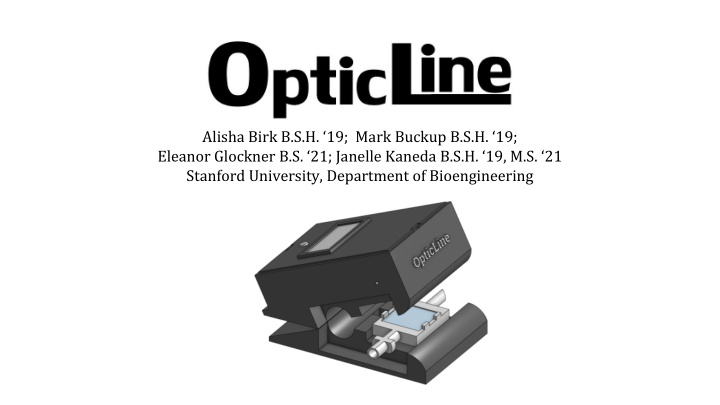



Alisha Birk B.S.H. ‘19; Mark Buckup B.S.H. ‘19; Eleanor Glockner B.S. ‘21; Janelle Kaneda B.S.H. ‘19, M.S. ‘21 Stanford University, Department of Bioengineering
Introduction ● 195,000 PD patients worldwide 1 → continuing to rise ● At home methods allow patients to have flexible and more consistent dialysis sessions... ● But also leads to peritonitis (infection of the peritoneum) ○ Hospitalization costs are $100 USD million annually 1-3 ○ 4-10 days to begin treatment 4-5 ○ Longevity decreases from 10 years to 2 years 6-7
Device Overview OpticLine uses a noninvasive optical method to detect early indicators of infection in peritoneal dialysis effluent fluid.
Device Overview The “knob” fits in line with the drain line using existing male/female connectors, and the “clamp” clamps externally over the knob.
Device Components OPTICAL WINDOW The “knob” fits in line with the drain line using existing male/female connectors, and the “clamp” clamps externally over the knob.
Device Dimensions
Optical Absorption Data: Mock Effluent Fluid Our initial testing showed that the OpticLine had comparable absorbance detection to the NanoDrop, the current standard for optical absorbance measurements. Both were able to detect a significant * * difference between Tantiyavarong, normal and infected et al . 8 samples in mock PD effluent fluid.
Existing Solutions Cost Patient Compliance
Go-to-Market Strategy & Business Model ● Provisional patent (US S19-158) ● Using a licensing model ○ Potential partners/investors from KidneyX connections & beyond ● Target market: Medicare ○ New legislation: Patient Access to ESRD New Innovative Devices Act (H.R. 2710)
Regulatory Pathway Class II 510(k)
Key Stakeholders PATIENTS HOSPITALS INSURANCE
Timeline Ongoing OCT 2019 JAN 30, 2020 Connect with Continue to Kidney X Phase II IRB Protocol potential licensees iterate prototype Submitted Approved & partners DESIGN PROTOTYPE EVALUATE
Human Factor Study of Peritoneal Dialysis Patients for Device Design IRB Approved ● For current/past PD patients/caretakers, nephrologists, nurses, etc. ● General questions about PD experience ● 3 prototypes: https://forms.gle/2JfPKLWf1inkYzQL 6 ○ For PD patients at LPCH: shown how to connect, then timed on own ○ Virtually: asked how willing to use
References 1. (J Am Soc Nephrol) Jain, et al., J Am Soc Nephrol. 2012 Mar; 23(3): 533–544. 2. (AJKD) Fried et al., AJKD. 1999 May; 33(5): 927-33. 3. Becker’s Hospital CFO Report: “Average cost per inpatient day across 50 states” 4. Children’s Hospital St. Louis:: “Infection Exposure Questions” 5. Kids Health: “Strep Test: Rapid” 6. (BMC Nephrol) Jaar, et al., BMC Nephrol. 2009 Feb;10(3): 1-12. 7. National Kidney Federation: “How Long Can I Remain on PD?” 8. (NCBI) Tantiyavarong, et al., Int J Nephrol. 2016; 6217135.
More recommend